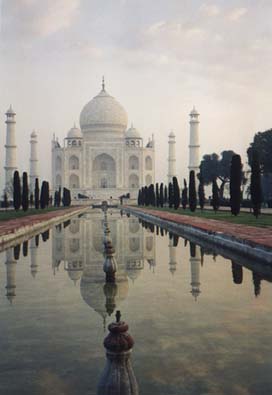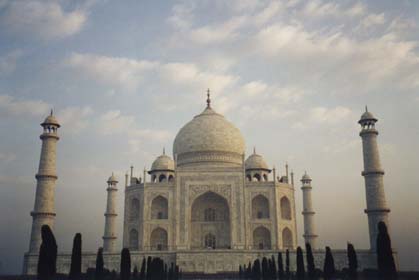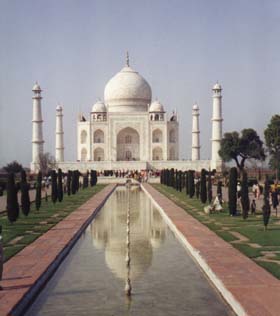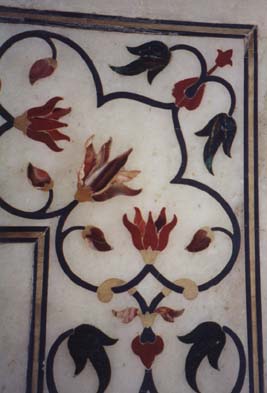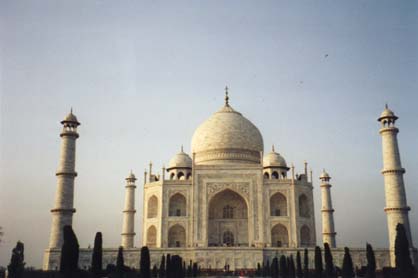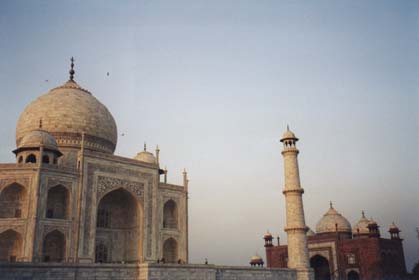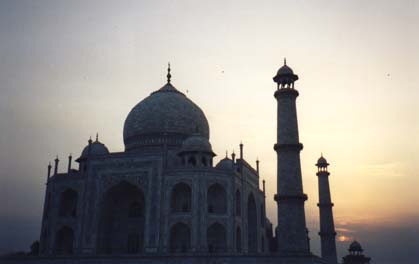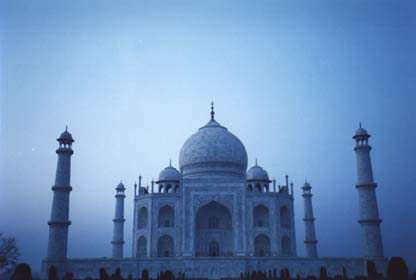|
Symmetry
In the garden pool, its symmetry is complete. The journey continues east a few days later by organ-churning bus from Jaipur to Agra. The Taj Mahal stands in the polluted skies, one of the largest tourist attractions in India. Born as a mausoleum for the dead wife of a grieving widow, it reflects the passing light of night and day. When his second wife, Mumtaz Mahal, died in childbirth in 1631, the Mughal Emperor Shah Jahan built the Taj Mahal in her memory and as her final resting place. I emerge from the darkness of the cavernous entrance building to the gardens of this monument to love. The changing light of day from sunrise to sunset magically alters the color and atmosphere of the Taj Majal.
The white marble of the Taj Mahal is nearly translucent as the sky lightens, its perfect symmetry reflected in the garden pool.
The clouds turn from pink to white. With the sun newly risen yet still low in the eastern sky, the white marble shows shades of gray in the shadows, and a yellow light burnishes its eastern side. According to a story that may well be apocryphal, Shah Jahan had planned to build a negative mirror image of the Taj Mahal in black marble as his own tomb. Unfortunately, he was deposed by his son Aurangzeb and imprisoned in Agra Fort before this second masterpiece could be carried out. Shah Jahan finished his years in Agra Fort with a view in the distance of his creation. When he died in 1666, Aurangzeb placed his tomb in the Taj Mahal next to that of Mumtaz Mahal. Ironically, the presence of Shah Jahan's tomb in the mausoleum's interior, something he never intended, is all that breaks its perfect symmetry.
At noon, the harsher light of midday brings a blinding vertical brilliance to the resplendent marble, inscribed with verses from the Koran and inlaid with semiprecious stones that form intricate floral designs.
By mid-afternoon, the yellow light returns, this time splashing the western face with the warmth of afternoon.
In
case you're wondering, no colors have been altered on these images;
As twilight falls, the monument settles into a blue rest, then vanishes in the fog of darkness falling. Large numbers of tourists have created a tourist ghetto, the Taj Ganj, which stretches immediately south of the Taj Mahal and sounds suspiciously like Delhi's Paharganj. As in any tourist ghetto, swindlers work overtime to part eager fools from their money. Agra is a contrast of scam and wonder. |

